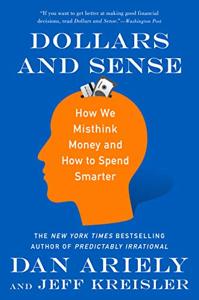
Want to learn the ideas in Dollars and Sense better than ever? Read the world’s #1 book summary of Dollars and Sense by Dan Ariely, Jeff Kreisler here.
Read a brief 1-Page Summary or watch video summaries curated by our expert team. Note: this book guide is not affiliated with or endorsed by the publisher or author, and we always encourage you to purchase and read the full book.
Video Summaries of Dollars and Sense
We’ve scoured the Internet for the very best videos on Dollars and Sense, from high-quality videos summaries to interviews or commentary by Dan Ariely, Jeff Kreisler.
1-Page Summary of Dollars and Sense
Overview
When we think of financially irresponsible decisions, we often think about people who go to casinos or buy expensive cars. But most financial miscalculations are happening on a smaller scale, such as whether it’s better to pay by card or cash. Most people probably don’t think that it matters because they’ll just pay off the whole balance at the end of the month. However, studies show that people spend more money when they use credit cards instead of cash because using cash makes them focus more on how much money they’re spending and what they’re buying.
What if you hired a locksmith and he took two minutes to change your lock? It costs the same as having him work for one hour. Most people would be mad at that, because they didn’t get much value from the service provider. But what’s the difference between those two situations?
This passage will give you a better understanding of the value of money and how we can make more informed financial decisions. You’ll learn about: What is money? The traits that define our modern currency, as well as common psychological mistakes people make when thinking about it. How we assess value: There are many methods for determining worth, but most don’t reflect true value. Tools to counter flawed thinking: It’s possible to be more conscious and deliberate in the financial decisions you make.
What Is Money?
Two friends, George and Matt, have been running for over an hour every day. They’ve decided to celebrate their commitment by taking a road trip to Atlantic City this weekend and gambling. Matt teases George about letting his money go rather than being stingy like he is known for being. George insists that he knows what’s worth spending his money on because of the smoothies they buy after work sometimes.
The next day, George and Matt go to the casino. They exchange their money for chips at the blackjack table and play a few hands of blackjack. George is aggressive with his bets, doubling down on some cards in order to win more money than he lost on others. He ends up $200 in debt after winning back $400 that he had previously lost earlier during the game. Matt is surprised by how well George played; maybe his friend isn’t so cheap after all when it comes to gambling?
People are often irrational when it comes to money. One common example is the way people spend money on small things (like smoothies) and then blow a lot of money on big things (like poker games). This happens because we divide our spending into mental categories, such as food, entertainment, or gambling. George didn’t feel bad about losing $1,200 at poker because he subconsciously divided his money into “casino” and “food” buckets in his mind. He thought of that $1,200 as casino money rather than real dollars that he could’ve spent elsewhere. This was made easier by turning the cash into chips at the casino so they felt like two different kinds of spending instead of one category: George’s dollars.
Nothing is free: Casinos are designed to get people to spend money, so George was primed by the time he and Matt even got to the front door. They received free parking for arriving after 6 p.m., and a waiter offered them a free energy drink on their way to their seats. By that point, George and Matt were in a good mood because of all these little perks, which affected their judgment when they sat down at the table.
George has a hard time buying the $6 smoothie because he literally has to hand over six wrinkled dollar bills. He is also having trouble finding $6 without busting out his credit card. Poker chips take away the pain of paying and make it easy to forget how much you’re spending, just like credit cards do.






